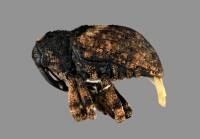Go to Encyclopedia of Life...
3. C. fuscatus, n. sp. Blackish brown, clothed with pale and dark-brown scales, and bunches of erect blackish bristles. Beak moderately stout, as long as the prothorax, carinate, striate and coarsely punctured at base, then naked and more finely punctured; antennae inserted nearly at the middle of the beak, slender, club pubescent, indistinctly annulate; head punctured, vertex very finely carinate. Prothorax as wide as long, strongly narrowed from the base, rounded on the sides, constricted in front, deeply and densely punctured, carinate; disc with three conspicuous tufts of bristles, and two smaller ones near the front margin; others scattered singly; scales brown, with three narrow indistinct lines of paler; base squarely truncate each side, prolonged into a distinct angle at the scutellum, which is black. Elytra one-third wider at base than the prothorax, humeri rounded, prominent, sides not dilated, but parallel, and then gradually narrowed behind, clothed mostly with pale-brown scales, darker at the base and tip, and with a broad middle band sometimes indistinct; striae fine, punctured, third, fifth and seventh interspaces more elevated; the third and fifth appear interrupted on account of crests of erect blackish bristles; of these there are three long ones on the third and three or four small ones on the fifth; also a few small bunches on the second interspace. Beneath clothed with pale-brown scales, deeply and densely punctured; thighs slender, not, or obsoletely toothed; tibiae straight, not angulated at base as in C. parochus and bisignatus. Length 5.5 mm.; .22 inch. Southern and Western States. So far as the meagre description given by Say goes, this species agrees well with his C. obliquus, but as Boheman and Say agree in stating that that name belongs to the species called by the former C. umbrosus, I do not feel at liberty to apply it to the present one, for which I have adopted the Catalogue name of Dejean. If our fauna had more representatives of this genus, I would separate this as a distinct division, differing from the preceding, not only by the tibiae and stouter beak, but by the ninth elytral interspace being not elevated, and by the post-ocular prothoracic lobes being more prominent.





























